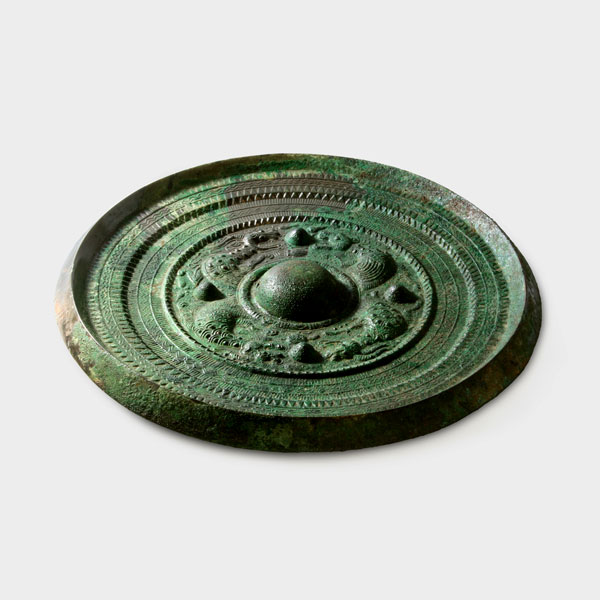Political Maturation and the Creation of Symbols of Authority
-

Mirror with Triangular RimDesign of Dragon and Tiger, Found at Izumikoganezuka Tumulus, Osaka, Kofun period, 4th-5th century (Important Cultural Property)
Japanese Archaeology and Special Exhibition (Heiseikan) Japanese Archaeology Gallery
May 8, 2025 (Thu) - October 5, 2025 (Sun)Around the end of the Yayoi period in the first half of the 3rd century, large burial mounds with regionally-distinct shapes began to appear in various areas from Kanto to Kyushu. Villages in Japan were changing to states, with some gaining the power to unify others. A Chinese historical document even noted that in 239 and 240, Queen Himiko, the ruler of Japan’s Yamatai Kingdom, sent envoys to the Wei dynasty.
During the latter half of the 3rd century, keyhole-shaped burial mounds of unprecedented size and construction began to appear in the Kinai region, with the largest concentration in the Nara basin. Objects symbolizing political authority, such as bronze mirrors and ornaments, accompanied those buried inside. These developments show that politics in Japan had matured under the new Yamato Kingdom, which was even more powerful than Yamatai. These burial mounds were constructed on a wide scale until the 7th century, giving this era the name Kofun (ancient burial mound) period.
The pottery of the Kofun period was haji earthenware. Unlike earlier Yayoi pottery, it was uniform in design and did not feature regionally-distinct decorative patterns. This section explores the beginning of the Kofun period through haji pottery and bronze mirrors that were brought from China and placed in burial mounds.
| Designation | Name | Creation/ Excavation/ Provenance |
Period | Acquisition/ Ownership/ Accession Number |
CMT | ||
| Highlight | Important Cultural Property | Slant-Rimmed Mirror with Two Deities and Two Beasts | Found at the Samita Takarazuka Tumulus, Nara | Kofun period, 4th–5th century (Created in China, 2nd–3rd century) | J-179 | ||
| Highlight | Wide-Mouthed Jar | Found at the Iwaseoyama Nekozuka Tumulus, Kagawa | Kofun period, 3rd–4th century | Gift of Kagawa Prefecture, J-6195 | |||
| Highlight | Gourd-Shaped Jar | Found in the Kyōnozuka Tumulus, Miyagi | Kofun period, 5th century | J-9011 | |||
| Highlight | Important Cultural Property | Mirror with Triangular Rim, Divinities and animals design | Excavated at Maebashi Tenjin'yama Tumulus, Maebashi-shi, Gunma | Kofun period, 4th century | J-38398-1b | ||
| Highlight | Important Cultural Property | Mirror with Triangular Rim, Design of Dragon and Tiger | Found at Izumikoganezuka Tumulus, Osaka | Kofun period, 4th-5th century | J-36931-23 | ||
| Highlight | Sculpted Rock with Intersecting Arcs (copy) | Original: Attributed from Tatezukijinja, Kurashiki-shi, Okayama | Original: Yayoi period, 3rd century | J-38389 |
